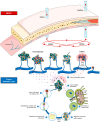The Role of Hyperthermic Intraperitoneal Chemotherapy in Uterine Cancer Therapy
- PMID: 37569726
- PMCID: PMC10419250
- DOI: 10.3390/ijms241512353
The Role of Hyperthermic Intraperitoneal Chemotherapy in Uterine Cancer Therapy
Abstract
Endometrial cancer and uterine sarcoma represent the two major types of uterine cancer. In advanced stages, both cancer entities are challenging to treat and correlate with a meagre survival and prognosis. Hyperthermic Intraperitoneal Chemotherapy (HIPEC) is a form of localized chemotherapy that is heated to improve the chemotherapeutic effect on peritoneal metastases. The aim of the current review is to study the role of HIPEC in the treatment of uterine cancer. A literature review was conducted using the MEDLINE and LIVIVO databases with a view to identifying relevant studies. By employing the search terms "hyperthermic intraperitoneal chemotherapy", "uterine cancer", "endometrial cancer", and/or "uterine sarcoma", we managed to identify 26 studies published between 2004 and 2023. The present work embodies the most up-to-date, comprehensive review of the literature centering on the particular role of HIPEC as treatment modality for peritoneally metastasized uterine cancer. Patients treated with cytoreductive surgery, alongside HIPEC, seem to profit from not only higher survival but also lower recurrence rates. Factors such as the completeness of cytoreductive surgery, the peritoneal cancer index, the histologic subtype, or the applied chemotherapeutic agent, all influence HIPEC therapy effectiveness. In summary, HIPEC seems to represent a promising treatment alternative for aggressive uterine cancer.
Keywords: cancer; chemotherapy; endometrial; hyperthermic; intraperitoneal; sarcoma; uterine.
Conflict of interest statement
The authors declare no conflict of interest.
Figures
Similar articles
-
Cytoreductive surgery (CRS) plus hyperthermic intraperitoneal chemotherapy (HIPEC) vs CRS alone for treatment of endometrial cancer with peritoneal metastases: a multi-institutional study from PSOGI and BIG RENAPE groups.BMC Surg. 2022 Jan 7;22(1):1. doi: 10.1186/s12893-021-01449-z. BMC Surg. 2022. PMID: 34996419 Free PMC article.
-
[Construction and evaluation of a nomogram for predicting the prognosis of patients with colorectal cancer with peritoneal carcinomatosis treated with cytoreductive surgery plus hyperthermic intraperitoneal chemotherapy].Zhonghua Wei Chang Wai Ke Za Zhi. 2023 May 25;26(5):434-441. doi: 10.3760/cma.j.cn441530-20230309-00071. Zhonghua Wei Chang Wai Ke Za Zhi. 2023. PMID: 37217351 Chinese.
-
[Efficacy of 1 384 cases of peritoneal carcinomatosis underwent cytoreductive surgery plus hyperthermic intraperitoneal chemotherapy].Zhonghua Wei Chang Wai Ke Za Zhi. 2021 Mar 25;24(3):230-239. doi: 10.3760/cma.j.cn.441530-20201110-00603. Zhonghua Wei Chang Wai Ke Za Zhi. 2021. PMID: 34645167 Chinese.
-
Effect of hyperthermic intraperitoneal chemotherapy in combination with cytoreductive surgery on the prognosis of patients with colorectal cancer peritoneal metastasis: a systematic review and meta-analysis.World J Surg Oncol. 2022 Jun 14;20(1):200. doi: 10.1186/s12957-022-02666-3. World J Surg Oncol. 2022. PMID: 35701802 Free PMC article.
-
Cytoreductive surgery with hyperthermic intraperitoneal chemotherapy for endometrial cancer-derived peritoneal metastases: a systematic review.Clin Exp Metastasis. 2019 Aug;36(4):321-329. doi: 10.1007/s10585-019-09970-5. Epub 2019 May 14. Clin Exp Metastasis. 2019. PMID: 31089843
Cited by
-
miR-126-5p suppresses HeLa and Ishikawa cell proliferation and migration via the RICTOR/AKT pathway.Discov Oncol. 2025 Apr 16;16(1):533. doi: 10.1007/s12672-025-02306-8. Discov Oncol. 2025. PMID: 40237863 Free PMC article.
-
A novel nanodrug for the sensitization of photothermal chemotherapy for breast cancer in vitro.RSC Adv. 2024 Jul 5;14(30):21292-21299. doi: 10.1039/d4ra01611d. eCollection 2024 Jul 5. RSC Adv. 2024. PMID: 38974230 Free PMC article.
-
Global trends in adolescent and young adult female cancer burden, 1990-2021: insights from the Global Burden of Disease study.ESMO Open. 2024 Nov;9(11):103958. doi: 10.1016/j.esmoop.2024.103958. Epub 2024 Oct 18. ESMO Open. 2024. PMID: 39426082 Free PMC article.
-
Carcinosarcoma of the Endometrium-Pathology, Molecular Landscape and Novel Therapeutic Approaches.Medicina (Kaunas). 2025 Jun 26;61(7):1156. doi: 10.3390/medicina61071156. Medicina (Kaunas). 2025. PMID: 40731786 Free PMC article. Review.
-
Executive Summary of the American Radium Society Appropriate Use Criteria for the Management of Peritoneal Carcinomatosis From Different Tumor Origins: Systematic Review and Guidelines.Cancer Med. 2025 Jul;14(14):e71043. doi: 10.1002/cam4.71043. Cancer Med. 2025. PMID: 40693544 Free PMC article. Review.
References
-
- Americal Cancer Society Key Statistics for Endometrial Cancer. [(accessed on 1 July 2023)]. Available online: https://www.cancer.org/cancer/types/endometrial-cancer/about/key-statist....
-
- National Cancer Institute Cancer Stat Facts: Uterine Cancer. [(accessed on 1 July 2023)]; Available online: https://seer.cancer.gov/statfacts/html/corp.html.
Publication types
MeSH terms
LinkOut - more resources
Full Text Sources
Medical



